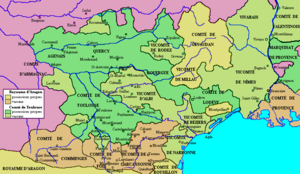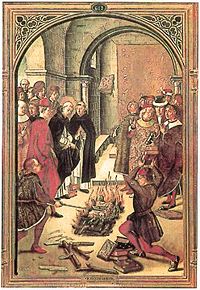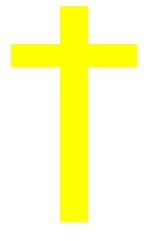Albigensian Crusade
2008/9 Schools Wikipedia Selection. Related subjects: Pre 1900 Military; Religious disputes
|
|||||
The Albigensian Crusade or Cathar Crusade (1209–1229) was a 20-year military campaign initiated by the Roman Catholic Church to eliminate the Cathar heresy in Languedoc. The Crusade was prosecuted primarily by the French and promptly took on a political flavour, resulting in not only a significant reduction in the number of practicing Cathars but also a realignment of southern France, bringing it into the sphere of the French crown and diminishing the distinct regional culture and high level of foreign influence.
When Innocent III's diplomatic attempts to roll back Catharism met with little success and after the papal legate Pierre de Castelnau was murdered (allegedly by an agent serving the Cathar count of Toulouse), Innocent III declared a crusade against Languedoc, offering the lands of the schismatics to any French nobleman willing to take up arms. The violence led to France's acquisition of lands with closer cultural and linguistic ties to Catalonia (see Occitan). Estimated from 200,000 to 1,000,000 people died during the crusade.
The Albigensian Crusade also had a role in the creation and institutionalization of both the Dominican Order and the Medieval Inquisition.
Origin
The Roman Catholic Church had always dealt vigorously with strands of Christianity that it considered heretical, but before the 12th century such groups were organized in small numbers, around wayward preachers or small localized sects. The Cathars of Languedoc represented an alarmingly popular mass movement, a phenomenon that the Roman Church had not seen for almost 900 years, since Arianism and Marcionism in the early days of Christianity. In the 12th century much of what is now Southern France was converting to Catharism, and the belief was spreading to other areas. The Cathars, along with other religious sects of the period such as the Waldensians, appeared in the cities and towns of newly urbanized areas. Although Cathar ideas had not originated in Languedoc, one of the most urbanized and populated areas of Europe at the time, for reasons unknown it was there that their theology found its most spectacular success.
The Cathars were especially numerous in what is now western Mediterranean France, then part of the Crown of Aragon. They were also called Albigensians; this is either because of the movement's presence in and around the city of Albi, or because of the 1176 Church Council held near Albi which declared the Cathar doctrine heretical. Political control in Languedoc was divided among many local lords and town councils. Before the crusade, there was little fighting in the area and a fairly sophisticated polity.
On becoming Pope in 1198, Innocent III resolved to deal with the Cathars. He first tried peaceful conversion, but the preachers sent out to return the schismatics to the Roman communion met with little success. Even St. Dominic succeeded in converting only a handful. The Cathar leadership was protected by powerful nobles, and also by some bishops, who resented papal authority in their sees. In 1204 the Pope suspended the authority of some of those bishops, appointing papal legates to act in his name. In 1206 he sought support for wider action against the Cathars from the nobles of Languedoc. Noblemen who supported Catharism were excommunicated.
The powerful count Raymond VI of Toulouse refused to assist and was excommunicated in May 1207. The Pope called upon the French king, Philippe II, to act against those nobles who permitted Catharism, but Philippe declined to act. Count Raymond met with the papal legate, Pierre de Castelnau, in January 1208, and after an angry meeting, Castelnau was murdered the following day. The Pope reacted to the murder by issuing a bull declaring a crusade against Languedoc – offering the land of the heretics to any who would fight. This offer of land drew the northern French nobility into conflict with the nobles of the south.
Military campaigns
The military campaigns of the Crusade can be divided into several periods: the first from 1209 to 1215 was a series of great successes for the crusaders in Languedoc. The captured lands, however, were largely lost between 1215 and 1225 in a series of revolts and military reverses. The situation turned again following the intervention of the French king, Louis VIII, in 1226. Although he died in November of that year, the struggle continued under King Louis IX. The area was reconquered by 1229, and the leading nobles made peace. After 1233 the Inquisition was central to crushing what remained of Catharism. Resistance and occasional revolts continued, but Catharism's days were numbered. Military action ceased in 1255. In the end, the Albigensian Crusade killed an estimated 1 million people, not only Cathars but much of the population of southern France.
Initial success 1209 to 1215
By mid 1209 around 10,000 crusaders had gathered in Lyon, before marching south. In June, Raymond of Toulouse, recognizing the disaster at hand, finally promised to act against the Cathars, and his excommunication was lifted. The crusaders turned towards Montpellier and the lands of Raymond-Roger de Trencavel, aiming for the Cathar communities around Albi and Carcassonne. Like Raymond of Toulouse, Raymond-Roger sought an accommodation with the crusaders, but he was refused a meeting and raced back to Carcassonne to prepare his defences.
In July the crusaders captured the small village of Servian and headed for Béziers, arriving on July 21. They invested the city, called the Catholics within to come out, and demanded that the Cathars surrender. Both groups refused. The city fell the following day when an abortive sortie was pursued back through the open gates. The entire population was slaughtered and the city burned to the ground. Contemporary sources give estimates of the number of dead ranging between seven and twenty thousand. The latter figure appears in the Papal Legate Arnaud-Amaury's report to the Pope. The news of the disaster at Béziers quickly spread and afterwards many settlements surrendered without a fight.
The next major target was Carcassonne. The city was well fortified, but vulnerable, and overflowing with refugees. The crusaders arrived on August 1, 1209. The siege did not last long. By August 7 they had cut the city's water supply. Raymond-Roger sought negotiations but was taken prisoner while under truce, and Carcasonne surrendered on August 15. The people were not killed, but were forced to leave the town — naked according to Peter of les Vaux-de-Cernay. "In their shifts and breeches" according to another source. Simon de Montfort now took charge of the Crusader army, and was granted control of the area encompassing Carcassonne, Albi, and Béziers. After the fall of Carcassonne, other towns surrendered without a fight. Albi, Castelnaudary, Castres, Fanjeaux, Limoux, Lombers and Montréal all fell quickly during the autumn. However, some of the towns that had surrendered later revolted.
The next battle centred around Lastours and the adjacent castle of Cabaret. Attacked in December 1209, Pierre-Roger de Cabaret repulsed the assault. Fighting largely halted over the winter, but fresh crusaders arrived. In March 1210, Bram was captured after a short siege. In June the well-fortified city of Minerve was invested. It withstood a heavy bombardment, but in late June the main well was destroyed, and on July 22, the city surrendered. The Cathars were given the opportunity to return to Catholicism. Most did. The 140 who refused were burned at the stake. In August the crusade proceeded to the stronghold of Termes. Despite sallies from Pierre-Roger de Cabaret, the siege was solid, and in December the town fell. It was the last action of the year.
When operations resumed in 1211 the actions of Arnaud-Amaury and Simon de Montfort had alienated several important lords, including Raymond de Toulouse, who had been excommunicated again. The crusaders returned in force to Lastours in March and Pierre-Roger de Cabaret soon agreed to surrender. In May the castle of Aimery de Montréal was retaken; he and his senior knights were hanged, and several hundred Cathars were burned. Cassès and Montferrand both fell easily in early June, and the crusaders headed for Toulouse. The town was besieged, but for once the attackers were short of supplies and men, and so Simon de Montfort withdrew before the end of the month. Emboldened, Raymond de Toulouse led a force to attack Montfort at Castelnaudary in September. Montfort broke free from the siege but Castelnaudary fell and the forces of Raymond went on to liberate over thirty towns before the counter-attack ground to a halt at Lastours, in the autumn. The following year much of the province of Toulouse was captured by Catholic forces.
In 1213, forces led by King Peter II of Aragon, I of Catalonia, came to the aid of Toulouse. The force besieged Muret, but in September a sortie from the castle led to the death of King Peter, and his army fled. It was a serious blow for the resistance, and in 1214 the situation became worse: Raymond was forced to flee to England, and his lands were given by the Pope to the victorious Philippe II, a stratagem which finally succeeded in interesting the king in the conflict. In November the always active Simon de Montfort entered Périgord and easily captured the castles of Domme and Montfort; he also occupied Castlenaud and destroyed the fortifications of Beynac. In 1215, Castelnaud was recaptured by Montfort, and the crusaders entered Toulouse. Toulouse was gifted to Montfort. In April 1216 he ceded his lands to Philippe.
Revolts and reverses 1216 to 1225
However, Raymond, together with his son, returned to the region in April, 1216, and soon raised a substantial force from disaffected towns. Beaucaire was besieged in May and fell after a three month siege; the efforts of Montfort to relieve the town were repulsed. Montfort had then to put down an uprising in Toulouse before heading west to captured Bigorre, but he was repulsed at Lourdes in December 1216. In September 1217, while Montfort was occupied in the Foix region, Raymond re-took Toulouse. Montfort hurried back, but his forces were insufficient to re-take the town before campaigning halted. Montfort renewed the siege in the spring of 1218. He was killed fighting in June.
Innocent III died in July 1216; and with Montfort now dead, the crusade was left in temporary disarray. The command passed to the more cautious Philippe II, who was more concerned with Toulouse than heresy. The crusaders had taken Belcaire and besieged Marmande in late 1218 under Amaury de Montfort, son of the late Simon. While Marmande fell on June 3, 1219, attempts to retake Toulouse failed, and a number of Montfort holds also fell. In 1220, Castelnaudary was re-taken from Montfort. He reinvested the town in July 1220, but it withstood an eight month siege. In 1221, the success of Raymond and his son continued: Montréal and Fanjeaux were re-taken, and many Catholics were forced to flee. In 1222, Raymond died and was succeeded by his son, also named Raymond. In 1223, Philippe II died and was succeeded by Louis VIII. In 1224, Amaury de Montfort abandoned Carcassonne. The son of Raymond-Roger de Trencavel returned from exile to reclaim the area. Montfort offered his claim to the lands of Languedoc to Louis VIII, who accepted.
French royal intervention
In November 1225 Raymond, like his father, was excommunicated. Louis VIII headed the new crusade into the area in June 1226. Fortified towns and castles surrendered without resistance. However, Avignon, nominally under the rule of the German emperor, did resist, and it took a three month siege to finally force its surrender that September. Louis VIII died in November and was succeeded by the child king Louis IX. But Queen regent Blanche of Castile allowed the crusade to continue under Humbert de Beaujeu. Labécède fell in 1227 and Vareilles and Toulouse in 1228. However, Queen Blanche offered Raymond a treaty: recognizing him as ruler of Toulouse in exchange for his fighting Cathars, returning all Church property, turning over his castles and destroying the defenses of Toulouse. Raymond agreed and signed the treaty at Meaux in April 1229. He was then seized, whipped and briefly imprisoned.
Inquisition
The Languedoc now was firmly under the control of the King of France. The Inquisition was established in Toulouse in November 1229, and the process of ridding the area of Cathar heresy and investing their remaining strongholds began. Under Pope Gregory IX the Inquisition was given great power to suppress the heresy. A campaign started in 1233, burning vehement and relapsed Cathars wherever they were found, even exhuming some bodies for burning. Many still resisted, taking refuge in fortresses at Fenouillèdes and Montségur, or inciting small uprisings. In 1235, the Inquisition was forced out of Albi, Narbonne, and Toulouse. Raymond-Roger de Trencavel led a military campaign in 1240. He was defeated at Carcassonne in October, then besieged at Montréal. He soon surrendered and was exiled in Aragon. In 1242, Raymond of Toulouse attempted to revolt in conjunction with an English invasion, but the English were quickly repulsed and his support evaporated. He was subsequently pardoned by the king.
The Cathar strongholds fell one by one. Montségur withstood a nine-month siege before being taken in March 1244. The final holdout, a small, isolated, overlooked fort at Quéribus, quickly fell in August 1255. The last known Cathar burning occurred in 1321.




